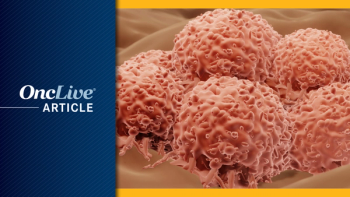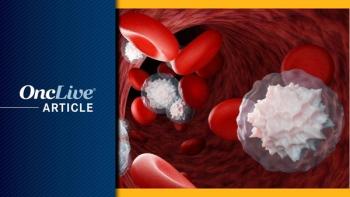
Rituximab/Lenalidomide Shows Sustained PFS Benefit in Indolent Non-Hodgkin Lymphoma
The combination of rituximab and lenalidomide maintained improved progression-free survival compared with rituximab alone in patients with relapsed/refractory indolent non-Hodgkin lymphoma, according to 5-year findings from the phase 3 AUGMENT trial.
The combination of rituximab (Rituxan) and lenalidomide (Revlimid) maintained improved progression-free survival (PFS) compared with rituximab alone in patients with relapsed/refractory indolent non-Hodgkin lymphoma, according to 5-year findings from the phase 3 AUGMENT trial (NCT01938001), which were presented at the
In the rituximab plus lenalidomide arm, the median PFS — which was the primary endpoint of the study — was 27.6 months (95% CI, 22.1-60.5) compared with 14.3 months (95% CI, 12.4-17.7) in the placebo arm (HR, 0.50; 95% CI, 0.38-0.66; P <.0001).
The overall survival (OS) in both the combination and placebo arms was not estimable (NE; HR, 0.59; 95% CI, 0.37-0.95; P = .0285). However, the 5-year OS rates were 83.2% vs 77.3% for the rituximab plus lenalidomide arm and placebo arms, respectively.
“The updated results for OS are consistent with the improvement observed in PFS. These results, including OS data, further support the use of the regimen as a standard of care for patients with relapsed/refractory indolent non-Hodgkin lymphoma,” John P. Leonard, MD, Richard T. Silver Distinguished Professor of Hematology and Medical Oncology at Weill Cornell Medicine, and lead author of this study, said during the presentation.
The study involved a total of 358 patients who were randomly assigned 1:1 to either the rituximab plus lenalidomide arm (n = 178) or the placebo arm (n = 180). In the combination arm, patients were given 20 mg of lenalidomide on days 1 to 21 of cycles 1 to 12, and rituximab was given at 375 mg/m2 on days 1, 8, 15, and 22 during cycle 1 and day 1 during cycles 2 to 5. Matched dose of placebo was given in the control arm.
Secondary endpoints included overall response rate, complete response, duration of response, OS, and time to next lymphoma treatment.
In the total population, the median age was 63 years; 48% were male; and 68% had an ECOG performance score of 0. In the combination arm, most patients had histology of follicular lymphoma (83%) vs marginal zone lymphoma (17%), with comparable rates in the placebo arm (82% vs 18%).
Between both arms, a majority of patients had 1 prior line of therapy (57% vs 54%). Prior rituximab treatment occurred in 85% of patients in the combination arm and 83% in the placebo arm, while 17% vs 14% were refractory to their last treatment regimen.
Overall, 70% of patients completed treatment in the rituximab plus lenalidomide arm vs 61% in the placebo arm; and 37% vs 43% discontinued the study. Reasons for study discontinuation included the withdrawal of consent (19% vs 12%), death (15% vs 26%), loss to follow-up (2% vs 4%), and other (1% vs 1%) in the combination and placebo arms, respectively. Of note, the final data cutoff date was January 26, 2022, and the median follow-up was 65.9 months.
The median time to next lymphoma treatment was 73.1 months (95% CI, 43.0-NE) in the rituximab plus lenalidomide arm vs 31.8 months (95% CI, 22.2-39.4) in the placebo arm (HR, 0.53; 95% CI, 0.39-0.71; P < .0001). Leonard pointed out that fewer patients in the combination arm received 1 or more lines of subsequent therapy (41%) compared with the placebo arm (61%).
Treatment-emergent adverse effects (TEAEs) that were grade 3/4 and which were observed in 69% of patients in the combination arm and 32% in the placebo arm, were related to lenalidomide or placebo in 57% vs 21%, or were related to rituximab occurred in 32% vs 11% of patients. Grade 5 TEAEs occurred in 2 patients each between both arms. Additionally, serious TEAEs occurred in 26% vs 14% of patients in the combination and placebo arms, respectively.
Of note, the overall safety profile remained consistent with the primary analysis, and investigators did not find any new signals.
Patients who received lenalidomide were more likely to receive a dose reduction (26%) than those receiving placebo (3%). Additionally, there was a higher interruption in lenalidomide treatment (64%) compared with placebo or rituximab (26%).
Secondary primary malignancies occurred in 7% of patients in the combination arm and 12% in the placebo arm, and included solid tumors (4% vs 8%), noninvasive non-melanoma skin cancer (3% vs 3%), and hematological malignancy (1% vs 2%).
In patients who died, secondary primary malignancies occurred in 2% in the combination arm and 3% in the placebo arm. The incidence rate of secondary primary malignancies per 100 patients-years was 1.62% (95% CI, 0.94%-2.78%) in the rituximab plus lenalidomide arm and 2.66% (95% CI, 1.73-4.07%) in the placebo arm.
Fewer patients with histologic transformations were observed in the combination arm (6%) compared with the placebo arm (8%). Additionally, the incidence rate per 100 patient-years was 1.24% (95% CI, 0.66%-2.30%) in the combination arm vs 1.85% (95% CI, 1.12%-3.07%) in the placebo arm.
Overall, 15% of patients in the combination arm died compared with 26% in the placebo arm. Causes of death included disease progression or disease complication (5% vs 14%), secondary primary malignancy or complication (2% vs 2%), AEs (2% vs 1%), other (5% vs 6%), or unknown (2% vs 4%) in the combination and placebo arms, respectively.
Reference
Leonard JP, Treny M, Offner F, et al. Five-year results and overall survival update from the phase 3 randomized study AUGMENT: lenalidomide plus rituximab versus rituximab plus placebo in patients with relapsed/refractory indolent non-Hodgkin lymphoma. Presented at the 2022 American Society of Hematology (ASH) Annual Meeting; December 10-13, 2022; New Orleans, LA. Abstract 230.

























































































